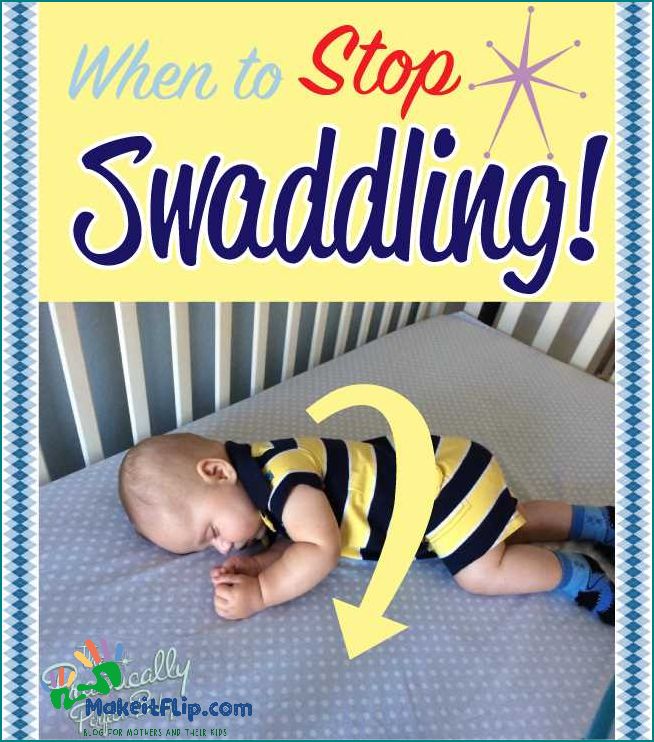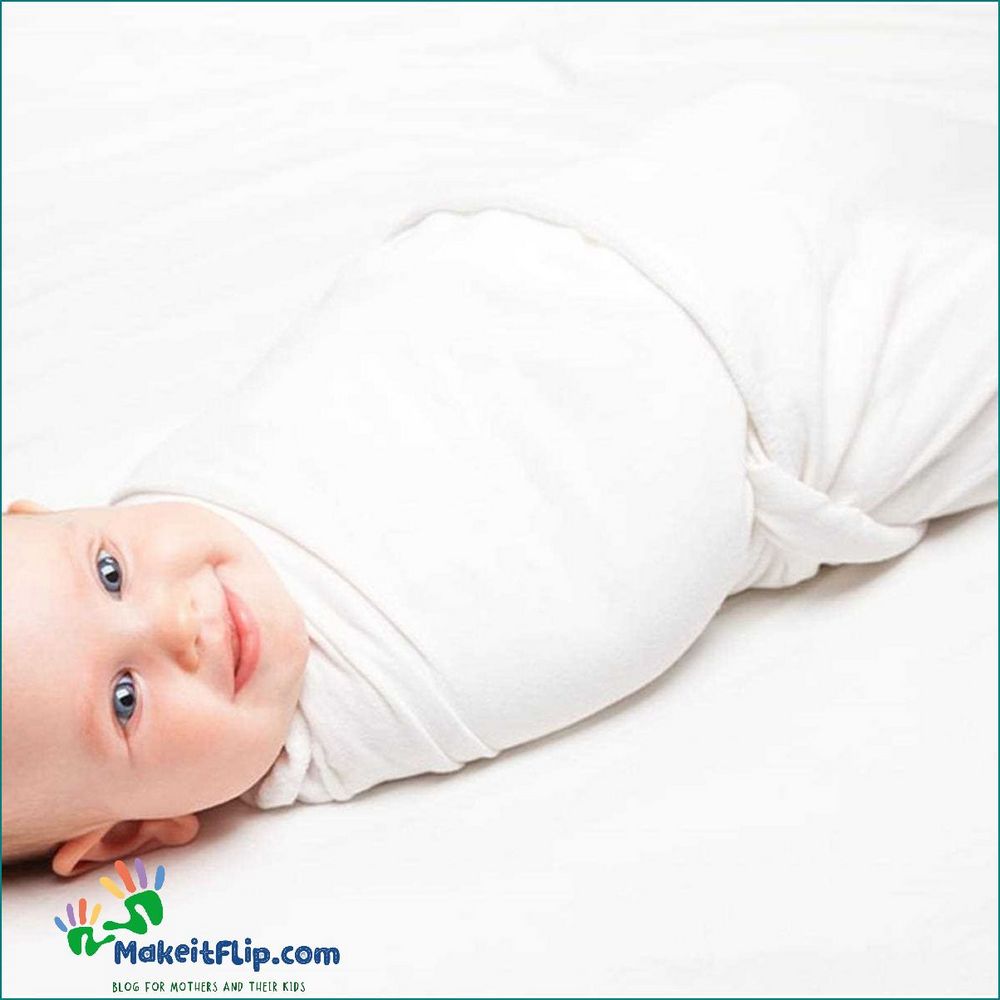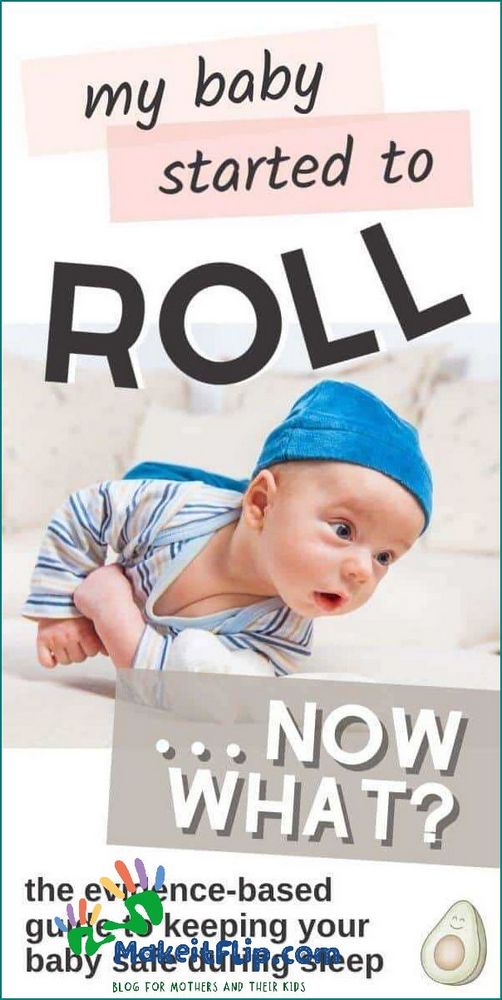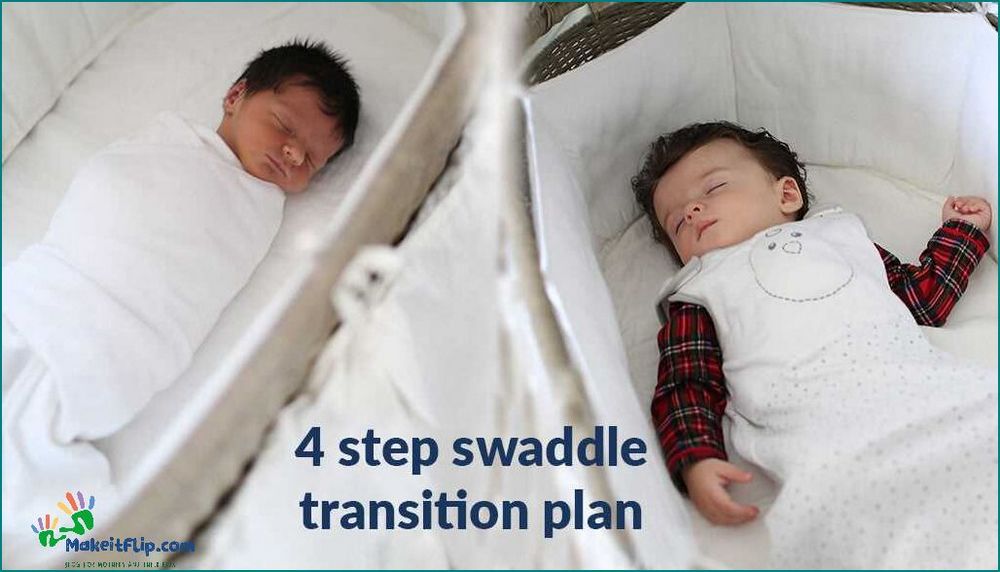Contents
Tips for Transitioning Your Baby from Swaddling to Sleeping Without a Swaddle Once They Begin Rolling Over

When your baby starts rolling over, it’s time to transition them out of the swaddle. Swaddling can be a great way to help your baby sleep in the early months, but once they can roll over, it becomes a safety hazard. Rolling over is an important milestone for your baby’s development, but it can also disrupt their sleep patterns.
So how do you help your baby sleep without a swaddle? It won’t be easy, but with a few strategies, you can make the transition smoother for both of you. First, create a consistent bedtime routine that signals to your baby that it’s time to sleep. This could include a warm bath, a gentle massage, or reading a bedtime story.
Next, make sure your baby’s sleep environment is conducive to sleep. Keep the room dark, quiet, and at a comfortable temperature. You can also try using white noise or a soft lullaby to help your baby relax and fall asleep. It may take some time for your baby to adjust to sleeping without the swaddle, so be patient and give them plenty of opportunities to practice.
Finally, provide your baby with a sense of security by using a transitional object, such as a lovey or a blanket. This can help them feel comforted and safe, even without the swaddle. Just make sure the object is safe and age-appropriate for your baby.
Remember, every baby is different, and what works for one may not work for another. It may take some trial and error to find the right strategies that help your baby sleep without a swaddle. But with time and patience, you can help your baby transition to sleeping without a swaddle and establish healthy sleep habits.
Understanding the Importance of Safe Sleep

When it comes to your baby’s sleep, safety should always be a top priority. While swaddling can be a helpful technique to soothe your baby and promote better sleep, it’s important to transition away from it once your baby starts rolling over. Swaddling can increase the risk of suffocation if your baby rolls onto their stomach and is unable to move their head to breathe.
Safe sleep practices are crucial to reduce the risk of Sudden Infant Death Syndrome (SIDS) and other sleep-related accidents. Here are some key points to consider:
- Always place your baby on their back to sleep. This position is the safest and reduces the risk of SIDS.
- Ensure that your baby’s sleep environment is free from hazards, such as loose bedding, pillows, stuffed animals, or crib bumpers.
- Use a firm and flat mattress that fits snugly in the crib. Avoid using additional padding or mattress toppers.
- Keep the room at a comfortable temperature to prevent overheating or chilling.
- Consider using a sleep sack or wearable blanket instead of a swaddle. These provide a cozy and safe alternative to keep your baby warm without the risk of suffocation.
- Monitor your baby closely during sleep to ensure they are safe and comfortable. Check on them regularly and make sure they are not overheating or in an unsafe position.
Remember, every baby is different, and what works for one may not work for another. If your baby is having difficulty sleeping without a swaddle, be patient and try different techniques to help them adjust. It may take some time for them to get used to sleeping without the swaddle, but with consistency and a safe sleep environment, they will eventually learn to sleep comfortably without it.
Creating a Safe Sleep Environment

When your baby starts rolling over during sleep, it’s important to create a safe sleep environment that allows them to sleep without a swaddle. Here are some tips to help ensure your baby’s safety while they sleep:
- Remove any loose bedding or toys from the crib. These items can pose a suffocation risk if your baby rolls over onto them.
- Use a firm mattress that fits snugly in the crib. This will help prevent your baby from getting trapped between the mattress and the crib sides.
- Place your baby on their back to sleep. This is the safest sleep position to reduce the risk of Sudden Infant Death Syndrome (SIDS).
- Keep the room at a comfortable temperature. A cool room with a temperature between 68-72°F (20-22°C) is ideal for sleep.
- Avoid using pillows, blankets, or crib bumpers. These can also pose a suffocation risk and should be removed from the crib.
- Consider using a sleep sack or wearable blanket instead of a swaddle. These can provide warmth and comfort without the need for a swaddle.
- Ensure that the crib is in good condition and meets safety standards. Check for any loose or broken parts and make any necessary repairs or replacements.
By creating a safe sleep environment, you can help ensure that your baby can sleep without a swaddle even when they start rolling over. Remember, it’s important to prioritize your baby’s safety while they sleep, but it’s also important to find a sleep solution that works for both you and your baby.
Knowing When to Transition from Swaddling

Swaddling can be a great way to help your baby sleep, but once they start rolling over, it’s time to consider transitioning out of the swaddle. Rolling over is a milestone that typically occurs around 4-6 months of age, and it’s a sign that your baby is developing their motor skills and becoming more mobile.
When your baby rolls over, swaddling can become a safety hazard. If your baby rolls onto their stomach while swaddled, they may have difficulty breathing. This is why it’s important to transition out of the swaddle once your baby starts rolling over.
There are a few signs that can indicate your baby is ready to transition from swaddling:
- Your baby is consistently rolling over during sleep
- Your baby is showing signs of frustration or resistance when swaddled
- Your baby is able to break free from the swaddle on their own
Once you notice these signs, it’s time to start the transition process. There are a few different methods you can try:
- Transition to a sleep sack: A sleep sack is a wearable blanket that allows your baby to move their arms and legs freely while still providing a cozy and secure feeling. This can help your baby feel comforted without the need for a swaddle.
- Gradual transition: Start by swaddling your baby with one arm out, then gradually transition to both arms out. This can help your baby adjust to sleeping without the swaddle over time.
- Use a transitional swaddle: There are swaddles available that have removable wings or straps, allowing you to gradually transition your baby out of the swaddle while still providing some level of comfort and security.
It’s important to remember that every baby is different, and what works for one may not work for another. Be patient and flexible as you navigate the transition from swaddling to sleeping without a swaddle. With time and consistency, your baby will adjust to the new sleep routine and continue to get the rest they need.
Gradually Transitioning from Swaddling

When your baby starts rolling over, it’s time to start transitioning them out of the swaddle. Swaddling can restrict their movement and increase the risk of suffocation once they are able to roll over.
However, transitioning from swaddling to sleeping without a swaddle can be challenging for both you and your baby. Here are some tips to help make the transition easier:
1. Start with one arm out: Begin by swaddling your baby with one arm out of the swaddle. This allows them to have some freedom of movement while still feeling secure. Observe how your baby reacts to this change and adjust accordingly.
2. Gradually transition to both arms out: Once your baby is comfortable with one arm out, you can start swaddling them with both arms out. This will further increase their freedom of movement and help them adjust to sleeping without the swaddle.
3. Use a transitional swaddle: If your baby is having a hard time adjusting to sleeping without the swaddle, you can try using a transitional swaddle. These swaddles have adjustable wings that can be gradually loosened over time, allowing your baby to gradually transition to sleeping without the swaddle.
4. Provide a safe sleep environment: Make sure your baby’s sleep environment is safe and conducive to sleep. Use a firm mattress, remove any loose bedding or toys, and keep the room at a comfortable temperature.
5. Establish a bedtime routine: A consistent bedtime routine can help signal to your baby that it’s time to sleep. This can include activities such as a warm bath, reading a book, or singing a lullaby.
6. Be patient: It may take some time for your baby to adjust to sleeping without the swaddle. Be patient and provide comfort and reassurance during this transition period. If your baby won’t sleep without the swaddle, try different techniques and consult with your pediatrician if needed.
Remember, every baby is different, and what works for one may not work for another. Trust your instincts as a parent and find a method that works best for you and your baby. With time and patience, your baby will learn to sleep without the swaddle and adjust to their newfound freedom of movement.
FAQ about topic How to Help Your Baby Sleep Without a Swaddle Even When They Start Rolling Over
What is swaddling?
Swaddling is the practice of wrapping a baby snugly in a blanket to help them feel secure and calm.
When should I stop swaddling my baby?
You should stop swaddling your baby once they start rolling over, as it can be a safety hazard if they are unable to move their arms and legs freely.
How can I help my baby sleep without a swaddle?
To help your baby sleep without a swaddle, you can try using a sleep sack or a wearable blanket, providing a safe sleep environment, establishing a bedtime routine, and using soothing techniques such as gentle rocking or white noise.
What are the risks of continuing to swaddle a baby who can roll over?
Continuing to swaddle a baby who can roll over can increase the risk of suffocation or strangulation if the swaddle becomes loose or covers their face. It can also hinder their motor development and limit their ability to explore and move freely.
What are some signs that my baby is ready to sleep without a swaddle?
Signs that your baby is ready to sleep without a swaddle include being able to roll over from back to tummy and vice versa, showing interest in moving their arms and legs, and being able to self-soothe or find a comfortable sleep position without being tightly wrapped.
I’m Diana Ricciardi, the author behind Makeitflip.com. My blog is a dedicated space for mothers and their kids, where I share valuable insights, tips, and information to make parenting a bit easier and more enjoyable.
From finding the best booster seat high chair for your child, understanding the connection between sciatica and hip pain, to exploring the benefits of pooping in relieving acid reflux, I cover a range of topics that are essential for every parent.
My goal is to provide you with practical advice and solutions that you can easily incorporate into your daily life, ensuring that you and your child have the best possible experience during these precious years.
